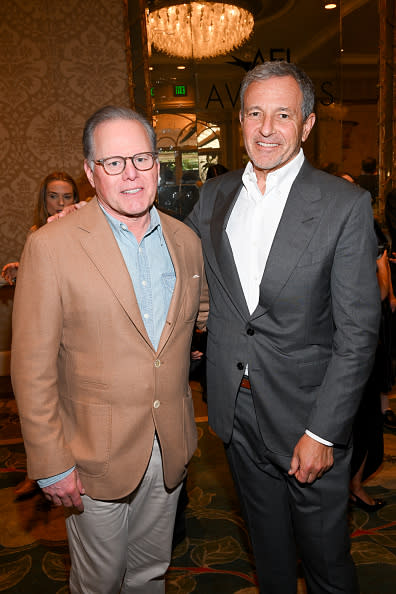The State of Streaming Bundles

- Oops!Something went wrong.Please try again later.
Summer is coming, but streamers want you to bundle up.
It has long not been an original thought to say that streaming is starting to look more and more like cable, but the industry has been taking new steps to ensure the comparison doesn’t die. On Tuesday, Comcast chief Brian L. Roberts revealed a coming bundle between NBCUniversal’s Peacock, Apple’s Apple TV+, and Netflix’s, well, Netflix. We did not get a price point or a launch date, but we do have a name: StreamSaver. Roberts promised significant savings, hence the name. (Look, we all made fun of “Peacock” when he announced that one too.)
More from IndieWire
'Fallout' Builds a World Unlike Any Other - Including the Video Game
How Two Showrunners See ChatGPT Fitting Into Their Writers' Rooms
If the StreamSaver announcement sounds familiar, it’s probably because that is the precise promise of an also newly announced Summer 2024 Disney bundle between Disney+, Hulu, and Max. Disney has long-experienced the strength of a bundle with two options for consumers to combine its in-house streaming services: the duo is Disney+ and Hulu, the trio adds ESPN+. The respective Disney Bundles are about 40 percent cheaper than subscribing to each service individually.
AMC Networks has bundles for some of its smaller services with its biggie; an AMC+ membership will also get you access to programming from streamers Shudder, Acorn TV, and Sundance Now.
Also recently, Fox, Warner Bros. Discovery, and Disney announced plans to launch a sports-streaming service, Venu, together this fall. That’s more a bundle of companies and their sports rights — a joint venture — than a streaming bundle. Now that Netflix has entered the live-sports arena in such a huge way, the Venu’s hope is that strength in numbers still counts for something.
Either way, neither Disney nor Comcast are first to play this game. Verizon of all companies pioneered the streaming bundle with a 41-percent-reduced rate for the Netflix and Max services, when combined, for certain wireless customers. One could argue that Hulu itself was the first streaming bundle, though like Venu it is again more-precisely a joint venture. NBC, Fox, and ABC launched that one together as a streaming home for their broadcast shows; CBS chose to stick with CBS All Access, now Paramount+. We’re not sure that was a great idea.
Since Hulu’s launch, Disney bought out Fox’s share (along with a ton of its other entertainment assets), NBC shows were pulled off of Hulu in favor of Peacock, and Disney bought out Comcast’s one-third share. (The buyout process is still ongoing. A third-party bank is currently calculating Hulu’s present-day valuation, or how much more Disney owes Comcast; it already paid $8 billion.)
Honorable mentions in the bundling game include 1) Paramount+ with Showtime and 2) Max, which is the combination of the former HBO Max and most of Discovery+ programming. Even bigger stretches than that one include 3) Amazon Prime Video, which can be bundled with other Prime services — including the free, fast shipping — and 4) Apple TV+, which also can be combined with other Apple services. Both Prime Video and Apple TV+ are available as standalone options.
Bundling doesn’t actually solve one problem that Paramount+ with Showtime, Max, or Disney+ with a Hulu tile does: integration. Disney+ and Max, or Netflix, Peacock, and Apple TV+, will remain separate services. The content-discovery problem remains real under a bundling setup.

Why is Hollywood (and Silicon Valley) going bundle-crazy anyway? Despite their flaws (like a discounted pie being divvied up two or three ways), bundles are the best method this side of consistently great content to reduce churn — or a subscriber canceling their membership. Netflix has the industry’s best churn rate, which makes it a very attractive service to bundle with.
Bundles also bring in big(ger) data, which is, in many ways, the currency of the day. A bundle also allows the involved companies to share (some) marketing costs and sell across more demos on ad-supported tiers. Finally, for us, bundles can improve the customer experience through ease of billing — and through reduced rates on said bill. Just like cable.
Let The Great Re-Bundling begin.
Best of IndieWire
The Best LGBTQ Movies and TV Shows Streaming on Netflix Right Now
Guillermo del Toro's Favorite Movies: 54 Films the Director Wants You to See
Nicolas Winding Refn's Favorite Films: 37 Movies the Director Wants You to See
Sign up for Indiewire's Newsletter. For the latest news, follow us on Facebook, Twitter, and Instagram.

